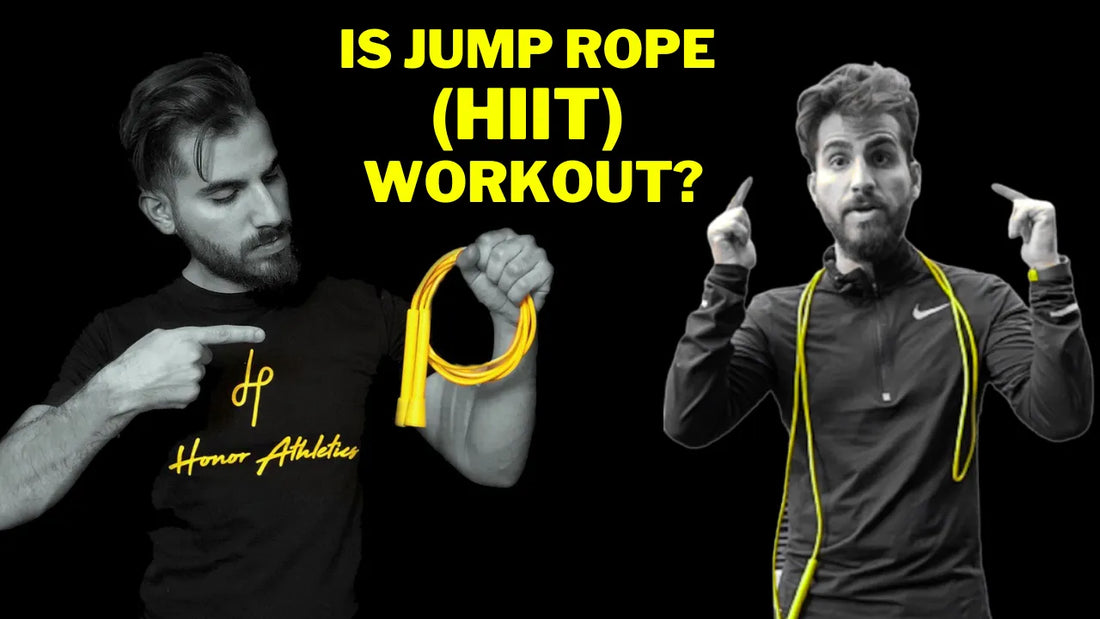
Is Jump Rope HIIT or Tabata Training?
Overview
Is Jump Rope HIIT cardiovascular training is perhaps the best mode of exercise to lose weight. Today, hundreds of research articles support the benefits of cardio training and advocate for its integration into everyone’s fitness routine.
Jump rope workout, in particular, is especially beneficial for weight loss purposes. However, it is far more than that. We covered the other benefits of jump rope exercises extensively in our other posts.
One question that keeps coming up among jump rope enthusiasts is whether this routine falls in the HIIT or Tabata training category.
To answer this question, we will briefly define HIIT and Tabata training, contrast the two modes of exercise, and see where jump rope workout falls into.
What is High-Intensity Interval Training (HIIT)?
High-Intensity Interval Training, or HIIT, is a form of cardiovascular exercise that focuses on short bursts of intense movements followed by relatively lower intensity recovery periods. Researchers consider this form of exercise to be the most time-efficient. In other words, you will achieve the most benefits in a very short period of time.
For reference, a standard HIIT workout lasts for 10 to 30 minutes. However, the reaped benefits are double compared to standard exercises. The exercises included in HIIT are cycling, sprinting, and even bodyweight exercises.
A HIIT jump rope training routine would look something like this: 30 seconds of jumping rope as fast as possible followed by a few minutes of slow, easy jumping rope.
Once you complete this step, it’s considered a repetition. Each workout typically consists of 3–6 repetitions. Some people refer to this as a series of workouts.
You can either perform the same series multiple times to complete one workout or mix things up.

What is Tabata training?
Tabata training is part of the HIIT routine. The opposite is not necessarily true.
In a standard Tabata workout, you will go all out for 20 seconds, then lower the intensity of your workout for 10 seconds. Typically, you would do this for 8 rounds.
This workout is designed to elevate your heart rate to the limits of the aerobic zone, followed by a window of rest. Most of the time, your body will enter the anaerobic zone, which means it can no longer use the usual ways to produce ATP. Instead, it will rely on alternative metabolic pathways that use less oxygen to generate energy.
The goal is to make the cells burn calories during and after exercise. Note that regular cardiovascular exercises mainly use calories during the actual workout.
In order to achieve the targeted goals, however, you need to push your body to its limits. You need to make your cells stop using the Krebs cycle to produce ATP and start using anaerobic metabolism. In this case, Tabata jump rope training could actually push you to anaerobic metabolism.

Summary – The difference between HIIT and Tabata training
Reading the two sections above might have left you confused – that’s completely understandable. At first glance, HIIT and Tabata training seem to be very similar.
So, what’s the difference?
HIIT is an umbrella term that covers all exercises with intervals of training and periods of rest. During the work period, you can either set a timer or do a number of repetitions before starting the rest phase. Regardless, you will try to exhaust yourself as hard as you can.
Here are the characteristics of a HIIT workout:
- Intervals that last for 2 to 3 minutes
- Resting periods for a few minutes
- The entire workout is around 20 to 40 minutes
Tabata training, on the other hand, focuses on time intervals and has shorter periods of rest. It is, nonetheless, a form of HIIT. If you opt for Tabata training, you will most likely exercise harder than you would during a classic HIIT routine.
Here are the characteristics of a Tabata workout
- Intervals that last for 20 to 30 seconds
- Resting periods for 10 seconds
- The entire workout is around 15 to 20 minutes
The table below demonstrates the key chracestics of each workout:
| HIIT | Tabata training | |
| Duration of intervals | 2-3 minutes | 20-30 seconds |
| Resting periods | Around 5 minutes | Around 10 seconds |
| Target heart rate | 80-95% of the maximal heart rate | More than 95% |
| Metabolism | Anaerobic | Anaerobic |
| Duration of the workout | 20-40 minutes | 15-20 minutes |
Is jump rope HIIT or Tabata training?
Placing jump rope in the category of HIIT or Tabata training is not a simple task. Depending on the intensity of the exercise you are performing and the rest periods you are taking, you can either do HIIT jump rope training or Tabata jump rope training.
For instance, doing 30 seconds of intense jumping rope followed by a few minutes of rest would qualify as a HIIT workout.
Switching off to a 20-second workout followed by 10 seconds of rest for 8 rounds would make this exercise part of Tabata training.
As you can see, jump rope workouts could qualify for HIIT as well as Tabata training. Moreover, it could also be a simple cardiovascular training if you decide to exclude the intervals.
Perhaps this is what makes jump rope workouts so great! You can easily switch routines and work on every muscle of the body with a simple rope.
Does this change the number of calories you can burn?
It’s important to highlight that regular jump rope exercises are among the top calorie-burning routines. Just think about this for a second; normal-intensity jump rope training can lead to significant caloric expenditure and weight loss.
If you switch your workout to HIIT or Tabata training, every muscle of your body will be on fire! You will lose a tremendous number of calories.
With that said, you need to be consistent in order to reach any real results. Doing a single Tabata training routine will not yield you the results you’re waiting for.
Takeaway message
Jump rope exercises can be part of HIIT or Tabata training, depending on the intensity of the exercise and the duration of recovery periods.
We hope that this article managed to answer any questions you had about the nature of jump rope workouts. Needless to say, HIIT jump rope training or Tabata jump rope training both offer significant benefits.
If you have questions about today’s topic or want to share your thoughts, feel free to drop a comment in the section below. Our inbox is also available for private messaging
Prev post

Jump Rope Vs. Running – Which One Is Better?
Updated on 09 December 2024
Next post

New Year Resolution With Jump Rope !
Updated on 09 December 2024



